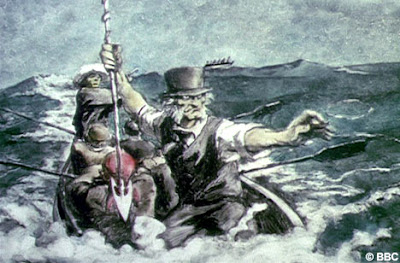
–
This week on EMS Office Hours, Jim Hoffman, Josh Knapp, and I mostly discuss whether needle decompression for tension pneumothorax[1] is overused and what the indications are for this poorly understood skill.
EMS Zebra Hunting Or Doing What’s Right?
Is needle decompression of tension pneumothorax overused?
Are we too aggressive with the harpoon?
Didn’t this get Ahab into trouble?
Is it safer to use something that is too short to be called a harpoon?
No.
A short needle does not work.
If you use a short needle, it is because it doesn’t matter if the patient has a tension pneumothorax, because the needle will not reach the pleural space.
If the needle will not reach the pleural space, there is no possible benefit.
OK, there is one possible benefit – if the patient responds to the painful stimulus of being stabbed in the chest, that is a potential benefit, but I don’t have a protocol to stab a patient in the chest to encourage breathing.
Many public agencies have lauded TCCC initiatives, citing anecdotal reports where TCCC interventions have prevented combat deaths.6,7 No study has rigorously analyzed battlefield application of both these devices to determine if they are being used appropriately in the field.[2]
We ought to find out, but a bigger study will be needed. Still, this is a good beginning – at least we are examining treatments.
–
Health care interventions are appropriate if performed properly for accepted indications. Conversely, inappropriate care occurs when an intervention is misused (improperly performed), overused (performed for an improper indication), or underused (not performed despite proper indications).8 [2]
If ND (Needle Decompression) is being done for no benefit, should we continue to use it?
If ND is being done with poor technique, and therefore not providing the intended benefit, should we continue to use it the same way?
If ND is being overused, and causing more harm than benefit, should we continue to use it the same way?
–
–
Underuse criteria
Seven (two coalition military, five Afghan army) soldiers presented with vital signs absent. One was from blunt trauma, three were from penetrating thoracic injury, and three were from blast injuries. None received NDs in the field.[2]
Misuse criteria
Seven NDs were performed on five soldiers for appropriate indications. All of these were Afghan army soldiers. All seven decompressions were performed at least 2cm medial to the midclavicular line. No major complications resulting from the NDs were identified.[2]
Overuse criteria
One Afghan soldier fell from standing during a unit physical fitness session. He reported unilateral chest pain but was otherwise stable. He was needle-decompressed twice in the field. Apparently, no “gush of air” was detected after each procedure was performed, so each needle was removed and the puncture sites were covered with sterile dressings.
Fortunately, a chest radiograph at hospital revealed no pneumothorax, despite the initial fall and subsequent attempts at ND.[2]
If I am going to use ND, then the patient should not be awake enough to feel it, or comfortable enough to care about being stabbed in the chest.
But is the way that we are currently using needle decompression safe and efficacious?
–
Despite widespread use of TCCC in combat care, very little has been reported on how TCCC interventions are actually being applied on the battlefield. This is particularly important as these skills have potential complications, and are being taught to many soldiers with nonmedical back-grounds before overseas deployments.1,2 [2]
Since we are stabbing the chest near the heart, we should not consider this to be a treatment to take lightly.
–
We were unable to determine if NDs actually saved lives or if failure to perform NDs (despite appropriate indications) resulted in preventable deaths. Most of these patients suffered severe multisystem injuries.[2]
Likewise, patients who presented with vital signs absent also had either accompanying severe brain injury, exsanguinating hemorrhage, or both, which might have accounted for their death, despite the lack of ND.[2]
So, we cannot tell, from this study, if there is more benefit or more harm, or if there is abny benefit or any harm.
Those who has the needle decompression might not have needed it and those who did not have needle decompression might have needed it.
–
All NDs were performed at least 2 cm medial to the midclavicular line, and well within the cardiac box.16 This error in technique risks inadvertent injury to the heart or great vessels,17[2]

Image credit. Location B is Bad.
Location A is good.
We tend to think of the clavicle as extending along line B in the image above. If we think that way, we end up putting the needle in between the sternum and the nipple. That is a mistake.
Line A is the actual position of the clavicle. We should not be placing the needle medial to the nipple. If we can’t follow that direction, we should place the needle in the side.
–
Footnotes:
–
[1] Tension pneumothorax
Wikipedia
Article
–
[2] An evaluation of tactical combat casualty care interventions in a combat environment.
Tien HC, Jung V, Rizoli SB, Acharya SV, MacDonald JC.
J Spec Oper Med. 2009 Winter;9(1):65-8.
PMID: 19813350 [PubMed]
Free Full Text Download in PDF format from Journal of Special Operations Medicine
–
Tien HC, Jung V, Rizoli SB, Acharya SV, & MacDonald JC (2009). An evaluation of tactical combat casualty care interventions in a combat environment. Journal of special operations medicine : a peer reviewed journal for SOF medical professionals, 9 (1), 65-8 PMID: 19813350
.





http://emspatientperspective.com/2012/08/31/knowing-when-to-hold-em/